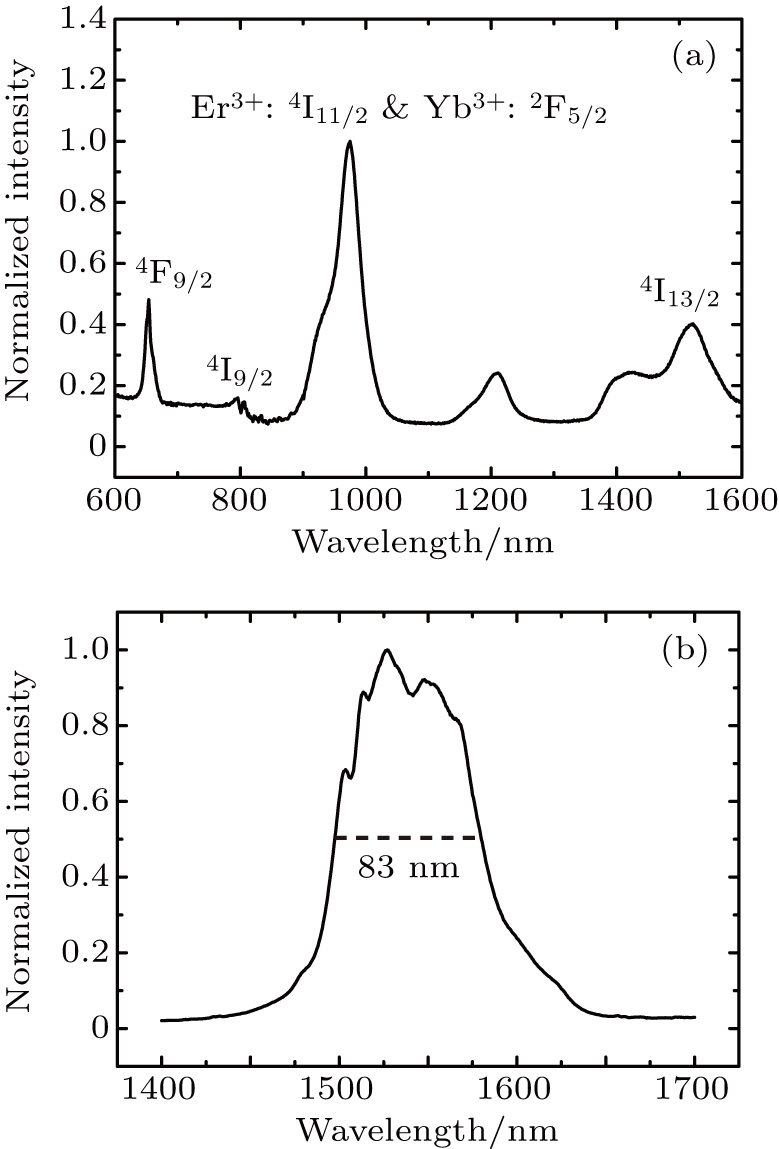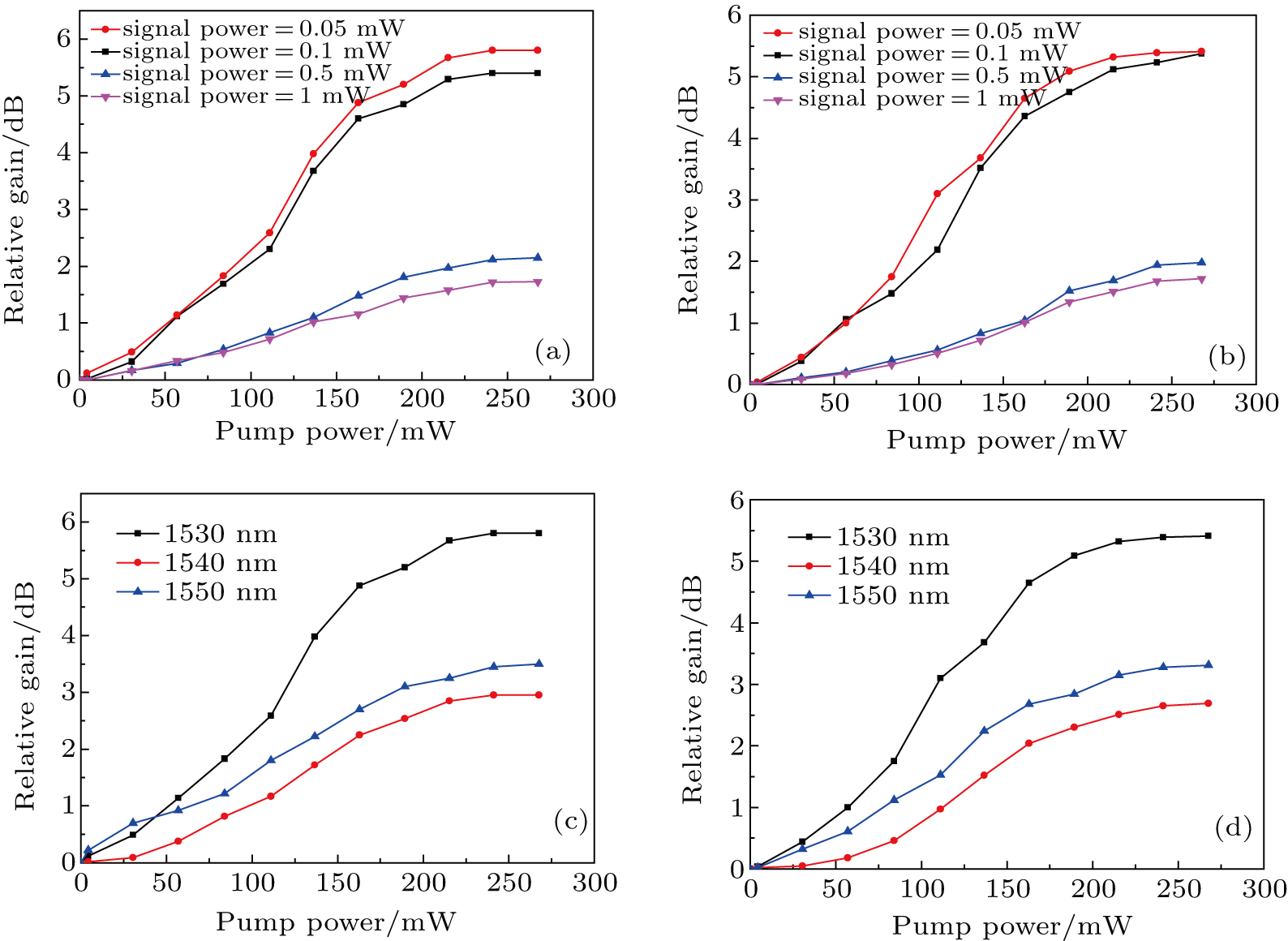† Corresponding author. E-mail:
A polymer waveguide Y-branch power splitter with loss compensation is proposed based on NaYF4:Er3+, Yb3+ nanocrystals prepared by a high temperature thermal decomposition method. The Y-branch power splitter is designed as a structure of embedded waveguide, and its core material is nanocrystals-doped SU-8. The insertion loss of the device is ∼15 dB. For an input signal power of 0.05 mW and a pump power of 267.7 mW, the two branches with 5.81-dB and 5.41-dB loss compensations at 1530 nm are achieved respectively. A polymer waveguide Y-branch power splitter with loss compensation has an important research significance.
In recent years, optical communication technology has received a lot of attention and been rapidly developed due to its fast and effective transmission characterization.[1–3] While chasing the extraordinary performance in optical transmission, the functions of processing signal are also required, which makes many optical devices widely used.[4–6] Optical waveguide Y-branch power splitter, achieving the functionality of an optical power splitter, is one of the important devices in the integrated optical circuits. It can be used as a basic unit in the optical integrated devices, such as switches, couplers, and interferometer or easy integration with other separate optical devices such as lasers, modulators, and wavelength division multiplexers (WDM). It has important application prospects in terms of optical communication, sensors, energy distribution, etc.[7–11]
To seek a better performance of the Y-branch power splitter, many materials have been used as the core of the waveguide. Li et al. fabricated a single mode Si–Ge Y-branch at 
With the development of the integrated photoelectronic device industry, higher integration has become a key element. Integrating more optical devices on a chip has been a major trend for a long period. In a highly integrated chip, the losses of individual devices will be superimposed on each other, which may cause a serious influence on the final quality of the photoelectronic chip. Therefore, optical amplifiers[15,16] and optical devices with loss compensation have become key components for photoelectronic device industry.[17–19]
Rare-earth (RE)-doped polymer, including erbium complex[20] and erbium-doped fluoride matrix nanoparticles, is widely used for fabricating optical waveguide amplifiers. Li et al. synthesized oleic acid (OA)-modified LaF3:Er,Yb nanoparticles, which could be used to synthesize the core material for the waveguide amplifiers.[21] Lei et al. synthesized OA-coated NaYF4:Er,Yb nanocrystals, which were doped into KMBR as the core material. The fabricated polymer waveguide amplifier with the above material achieved a relative gain of 4.7 dB/cm.[22] NaYF4 is a fluoride matrix material with low phonon energy and high stability. Erbium and ytterbium co-doped NaYF4 nanocrystals can generate photoluminescence around 1530 nm under 980-nm laser excitation, which has become a popular material for waveguide amplifiers and loss compensation devices.[23,24] In 2013, Zhai et al. synthesized NaYF4:Yb3+, Er3+, Ce3+-doped SU-8 2005 polymer waveguide amplifiers and reported a relative gain of 4.0 dB/cm.[25] Two years later, Yin et al. fabricated an optical waveguide amplifier based on erbium–ytterbium co-doped NaYF4 nanocrystals doped into SU-8. The gain of the device was 3.42 dB/cm.[26] With NaYF4:Er,Yb nanocrystals, Xing et al. fabricated a polymer waveguide thermo-optical switch with loss compensation. The loss compensation of the device was 3.8 dB at 1530 nm.[18]
In view of the importance of optical devices with loss compensation in optical fiber communication, in this work we propose, design, and successfully fabricate a Y-branch power splitter device with loss compensation. To achieve a better performance of the Y-branch power splitter, SiO2 is chosen as the bottom cladding of the device and therefore making it easy to integrate with other optoelectronic devices. The Y-branch with a structure of rectangular groove is fabricated by etching SiO2, and the core material is filled into the groove to obtain the complete waveguide structure. By this method, we realize a better waveguide topography, and the insertion loss is reduced effectively. First, NaYF4:Er3+, Yb3+ nanocrystals are synthesized by using a high temperature thermal decomposition approach and their morphologies are characterized. We use Rsoft and COMSOL software to simulate the optical field of the device and the power distribution of the Y-branch power splitter. The characteristic parameters of the Y-branch are designed and optimized by using the simulated results. Then the nanocrystals are doped into SU-8 as the core material of the optical waveguide amplifier and spin-coated on the surface of the etched SiO2 groove to realize a structure of embedded waveguide. Polymethyl methacrylate (PMMA) is used as the upper cladding. Throughout the fabrication, the traditional semiconductor technology such as spin-coating, photolithography, and development is used. Finally, the performance of the device is tested by the direct coupling.
The loss compensation principle of Y-branch power splitter is based on optical amplification of the Er3+–Yb3+ co-doped system at 1530-nm wavelength under the 980-nm excitation. The energy level of Er3+–Yb3+ co-doped system is shown in Fig. 








In this work, NaYF4:Er3+, Yb3+ nanocrystals were synthesized by using a high temperature thermal decomposition approach. 



The NaYF4:Er3+,Yb3+ nanocrystals were characterized in terms of their morphology and emission properties. The sizes of the samples were characterized by a transmission electron microscopy (TEM: JEOL JSM-7500F). Figure 
 | Fig. 2. (a) The TEM image of NaYF4:Er3+, Yb3+ nanocrystals (b) histogram of particle size distribution. |
The structure of the waveguide Y-branch power splitter was designed based on the cosine curve. Figure
 |


The two branches have the same optical properties, including the same material, structure, and waveguide width. When the signal light reaches the branch point, the power will be evenly output into the two branches, making the Y-branch a 3-dB power splitter.
As shown in Fig. 


 | Fig. 6. (a) Schematic diagram of cross-section and (b) simulated optical field distribution in waveguide. |
The optical power distribution of the waveguide under the transverse magnetic (TM) polarization was simulated by Rsoft. Figure
High-concentration nanocrystals doped in SU-8 will cause the breakage on the waveguide during photolithography and development. Therefore, we used an embedded waveguide structure to overcome this difficulty. By etching the SiO2, we obtained the rectangular grooves with the shape of Y-branch. Then the nanocrystals-doped SU-8 was spin-coated to fill the groove. Finally, PMMA was spin-coated as the upper cladding of the device.
Figure
First, we cleaved both input cross-section and output cross-section of the Y-branch power splitter. Each port of the device was separately coupled to the optical fiber by direct coupling. Figure
The relative gain of the device was calculated from the following formula:
 |


The test results are shown as follows. Figure
 | Fig. 11. (a) Output pattern of device, (b) Y-branch power splitter with upconversion luminescence under excitation at 980 nm. |
Each of branches was tested separately. When the signal light power was 1 mW, the insertion losses of two branches were −14.8 dB and −15.1 dB at 1530 nm, respectively. Figure
In this work, we doped the NaYF4:Er,Yb nanocrystals into SU-8 as amplification material. Rare-earth nanocrystals can be doped in many polymer materials by different methods. Polymethyl methacrylate (PMMA) is a common polymer and the main component of polymer fiber. Compared with doping nanocrystals into the polymer, nanoparticles-PMMA covalent-linking is a good method in terms of reducing the aggregation of nanocrystals and increasing the nanocrystals doping concentration in polymer matric. Optical waveguide devices with loss compensation will play an important role in photonic integration on chip.
In this work, a polymer waveguide Y-branch power splitter with loss compensation based on NaYF4:Er3+, Yb3+ nanocrystals is proposed and investigated. During the fabrication of the device, SiO2 is used as the bottom cladding, nanocrystal-doped SU-8 as the core material, and PMMA as the upper cladding. The whole device is designed with a structure of embedded waveguide. The fabricated device realizes the functions of power splitting and loss compensation. The insertion loss for each of the two branches of the Y-branch power splitter is about 15 dB. When the 980-nm pump power is 0.05 mW and the signal power is 267.7 mW, the maximum relative gain of a single branch is 5.81 dB at 1530 nm. The proposed Y-branch power splitter with loss compensation can improve the stability of optical device and therefore has a great research significance.
| [1] | |
| [2] | |
| [3] | |
| [4] | |
| [5] | |
| [6] | |
| [7] | |
| [8] | |
| [9] | |
| [10] | |
| [11] | |
| [12] | |
| [13] | |
| [14] | |
| [15] | |
| [16] | |
| [17] | |
| [18] | |
| [19] | |
| [20] | |
| [21] | |
| [22] | |
| [23] | |
| [24] | |
| [25] | |
| [26] |










